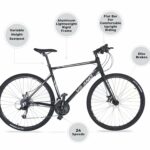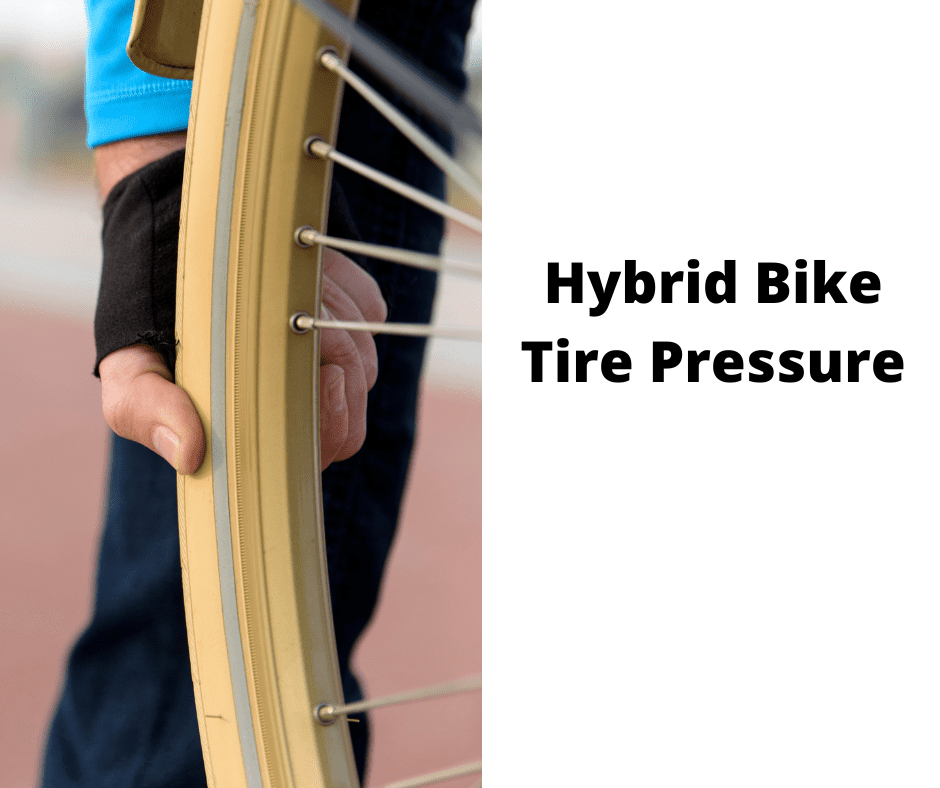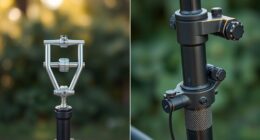Choosing between a hybrid and a road bike depends on your riding goals and terrain. If you want comfort, versatility, and easier handling for city streets or light off-road trails, a hybrid suits you best. For speed, longer distances on paved roads, and a more aerodynamic position, a road bike is ideal. Consider your preferred riding style and terrain, and if you continue exploring, you’ll find detailed advice to help you decide.
Key Takeaways
- Consider your riding terrain: hybrids suit mixed surfaces, while road bikes excel on paved, smooth roads.
- Prioritize comfort versus speed: hybrids offer an upright, cushioned ride; road bikes focus on aerodynamic efficiency.
- Think about riding distance and purpose: hybrids are ideal for commuting and leisure, road bikes for racing and long-distance rides.
- Evaluate handlebar preference: flat handlebars provide control on hybrids; drop bars enhance aerodynamics on road bikes.
- Match your skill level and gear needs: hybrids often have versatile gearing; road bikes feature specialized, performance-oriented components.
Understanding the Purpose and Use of Each Bike Type
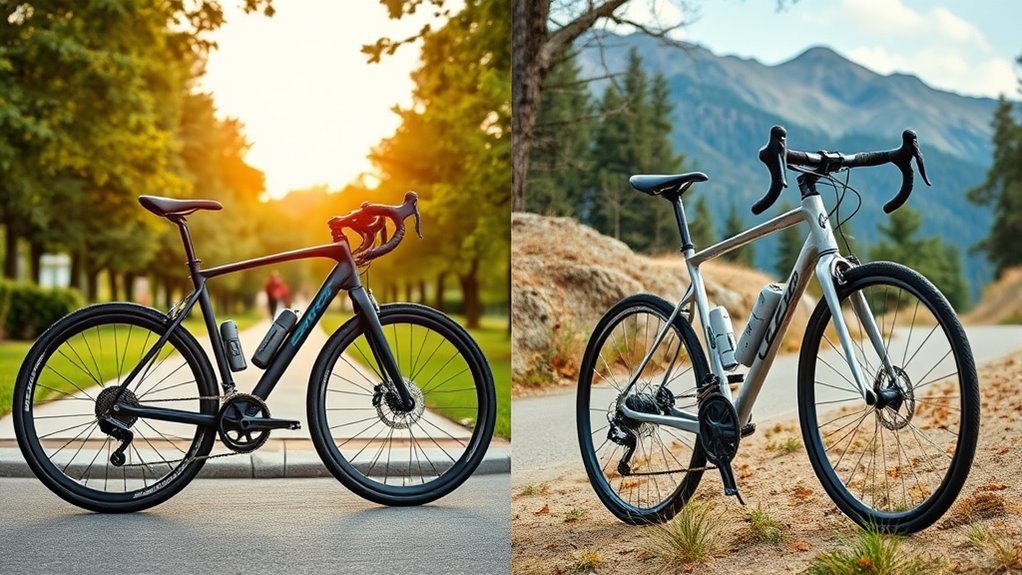
Have you ever wondered which bike is best suited for your riding needs? Hybrid bikes are designed for versatility and comfort, making them perfect for casual commuting, light touring, and riding on city streets, gravel, or light trails. They feature relaxed geometry, flat handlebars, and wider tires that provide stability and ease during your ride. In contrast, road bikes are built for performance and speed, optimized for paved roads and long-distance riding. Their aggressive geometry and drop handlebars enhance aerodynamics, helping you go faster with less effort. Knowing the purpose of each bike type guides your choice: hybrids prioritize comfort and adaptability, while road bikes focus on speed and efficiency. Both are tailored to different riding environments and goals, ensuring you get the right fit.
Comparing Frame Geometry and Riding Positions
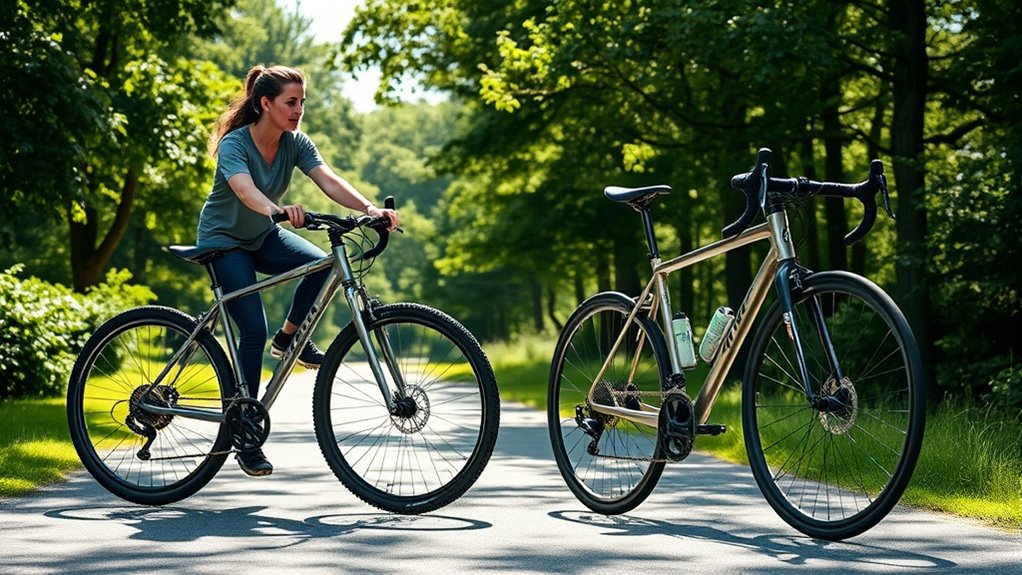
Your riding posture varies markedly between hybrid and road bikes due to their frame designs. Hybrid frames offer a more upright position for comfort and control, while road bikes promote a forward-leaning stance for speed. These differences impact handling, reach, and how each bike feels during your ride. Additionally, the frame geometry influences how comfortable you will feel over extended rides and can affect your overall riding efficiency. When choosing between the two, consider how different nail styles can enhance your personal style and confidence on the bike. Selecting the right bike fit ensures optimal comfort and performance tailored to your riding style. Understanding how riding position affects your muscle engagement can also help you make a more informed decision. Properly adjusting your gear shifting can further optimize your ride, especially on varied terrains.
Riding Posture Differences
The frame geometry of hybrid and road bikes substantially influences your riding posture, affecting comfort and performance. Hybrids promote an upright riding position, thanks to shorter top tubes and handlebar types like flat bars, which offer better visibility and control. In contrast, road bikes have longer top tubes and drop handlebars, positioning you forward and lowering your body for aerodynamics. The geometric design impacts body position and handlebar height, with road bikes requiring more core strength. A wider tyres setup on hybrids enhances stability, while seat height adjustments improve comfort. Your choice determines whether you adopt a relaxed posture suited for casual rides or a more aggressive stance for speed. Additionally, the frame materials used can influence ride quality and weight, further customizing your experience. Understanding how bike geometry affects riding ergonomics can help you select the most suitable bike for your needs, especially considering ergonomic design principles that optimize comfort during extended rides. Furthermore, the adjustable components on hybrid bikes allow riders to fine-tune their setup for optimal comfort and performance, and being aware of ergonomic adjustments can significantly improve riding comfort.
Frame Length and Reach
Frame length and reach play a significant role in shaping your riding posture and overall comfort. The frame reach, determined by the length of the top tubes and reach measurements, directly influences your cycling position and bike fit. Hybrids typically have shorter frame reach and frame length, resulting in an upright, relaxed posture that’s easier to control at lower speeds. In contrast, road bikes feature longer top tubes and reach, allowing for a lower, more aerodynamic stance that reduces wind resistance. Your rider posture adjusts based on frame geometry and handlebar height, impacting comfort over long distances. A proper fit ensures your cycling position supports efficiency and reduces strain. Understanding these differences helps you choose a bike that aligns with your riding style and comfort preferences. Additionally, selecting the appropriate tire size can improve ride quality and handling on different terrains. Recognizing the importance of bike fit can further enhance your riding experience and prevent discomfort or injury. Moreover, considering frame geometry can aid in customizing your bike to match your unique riding needs and preferences. Properly matching your bike’s components with your body dimensions, including reach measurements, ensures optimal comfort and performance.
Handling and Control
Handling and control are heavily influenced by the bike’s geometry and riding position. Hybrid bikes have shorter top tubes and upright frames, providing stability and ease of handling on mixed terrains. Road bikes feature longer top tubes and a forward-leaning stance, enhancing steering precision but reducing maneuverability. The handlebar choice also impacts control: hybrids with flat bars offer wider grip and greater stability, ideal for casual riding. Road bikes with drop bars increase speed and aerodynamic positioning but demand more skill for precise steering. Frame design directly affects handling, with hybrids favoring relaxed control and stability, while road bikes prioritize agility and sharp maneuvering.
| Aspect | Hybrid Bike | Road Bike |
|---|---|---|
| Frame Geometry | Shorter top tube, upright riding position | Longer top tube, forward-leaning stance |
| Handlebar Type | Flat, wide grip | Drop bars for aerodynamics |
| Stability & Maneuverability | Greater stability, easier control | Agile, more responsive steering |
| Ride Focus | Comfort and stability | Speed and agility |
Examining Gears, Brakes, and Component Options
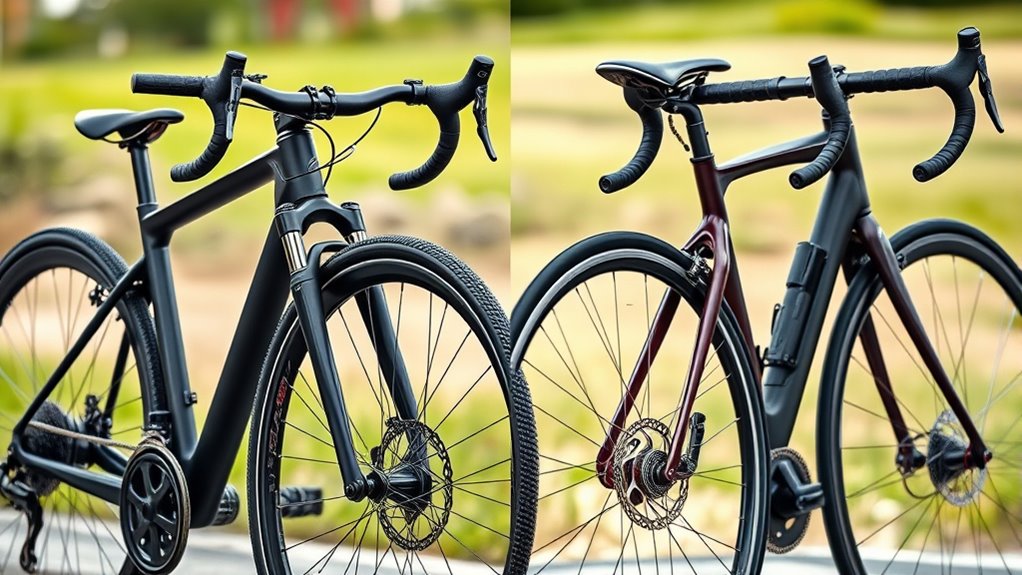
When choosing between hybrid and road bikes, it’s important to contemplate their gear ranges, brake systems, and component quality. Road bikes often have a 2x setup with high-end electronic shifting, while hybrids usually feature 3x gear configurations with mechanical brakes. Understanding these options helps you select the bike that best matches your riding style and terrain. Additionally, considering appliance compatibility can improve the overall riding experience, especially if integrating accessories or electronic components. As the market for smart bike technology continues to grow, selecting components that support these innovations can provide added convenience and functionality. Moreover, assessing the leadership potential of your bike components can ensure you choose durable and reliable parts for long-term performance. Evaluating component durability is essential to maintain performance over time and prevent frequent replacements. Incorporating user feedback and reviews can also help in selecting the most dependable components for your specific needs.
Gear Range Diversity
Gear range diversity plays a crucial role in differentiating hybrid bikes from road bikes. Hybrid bikes often feature 3x gearing setups with three front chainrings, offering a wide gear range for versatile riding. In contrast, road bikes typically use 2x gear systems optimized for speed and climbing. You’ll notice hybrids frequently include mechanical cable shifters, providing straightforward gear shifts, while high-end road bikes often incorporate electronic transmission for precision. Consider the gear options: hybrids focus on gear variety to handle various terrains, while road bikes prioritize streamlined gear ratios for performance. Visualize these differences:
- Wide gear ranges for hill climbing and city commuting
- Multiple gear options for different riding styles
- Differing gear ratios tailored to terrain
- Mechanical or electronic gear shift systems
- Diverse component brands balancing durability and performance
Additionally, understanding potential pitfalls in adopting new gear technologies can help prevent operational disruptions and security vulnerabilities. Recognizing the importance of research-backed components can further ensure reliability and safety in your riding experience.
Brake System Types
Have you ever wondered how brake systems differ between hybrid and road bikes? Both types often use rim brakes or mechanical disc brakes, which are simple and affordable. Higher-end models may feature hydraulic disc brakes, offering superior stopping power and better modulation, especially in wet or muddy weather conditions. Disc brakes, whether mechanical or hydraulic, deliver consistent performance regardless of the terrain. Road bikes frequently combine hydraulic disc brakes with electronic shifting, reducing cable clutter and boosting precision. Rim brakes are lighter and easier to repair roadside but provide less stopping power in adverse weather. The brake system you choose impacts your riding experience, balancing maintenance, weight, and braking efficiency across different conditions.
Component Quality Levels
Component quality levels considerably influence both hybrid and road bikes, affecting their performance, durability, and ease of maintenance. Higher-end models feature Shimano Deore or SRAM SX groupsets, offering smoother shifting and better durability. Road bikes often use lightweight, high-performance groupsets like Shimano Ultegra, Dura-Ace, or SRAM Force, providing precise shifting and reduced weight. Disc brakes can be hydraulic or mechanical, with hydraulic disc brakes delivering superior modulation and stopping power. Visualize:
- Smooth, effortless gear changes
- Lightweight components enhancing speed
- Durable frames with high-quality groupsets
- Hydraulic disc brakes for all-weather control
- Easy component upgrade options for better performance
Choosing components wisely impacts your ride quality, reliability, and future upgrade possibilities.
Analyzing Wheels, Tyres, and Handling Capabilities

Wheels and tires play a crucial role in a bike’s handling, with their size and tread pattern directly affecting ride quality and control. Wheel sizes like 700c are standard, but hybrids sometimes feature wider rims to accommodate wider tires for off-road use. Tire width influences handling capabilities: wider tires, ranging from 28mm to 40mm, provide better grip and ride comfort, especially on uneven surfaces, while narrower tires, around 25mm to 28mm, reduce rolling resistance for speed on smooth pavement. Tread patterns also impact control; hybrid tires often have textured treads for versatile grip, whereas slick road tires prioritize minimal rolling resistance. Overall, choosing the right tire width and tread pattern helps optimize handling, ensuring you get the desired balance between speed, comfort, and stability.
Assessing Comfort and Terrain Suitability

When choosing between a hybrid bike and a road bike, evaluating how each model aligns with your comfort and the terrain you plan to ride on is essential. Hybrid bikes offer an upright position with flat handlebars and relaxed geometry, enhancing comfort and visibility on diverse terrain. This setup reduces strain on your lower back and neck, making for a smooth, casual ride. In contrast, road bikes feature drop handlebars and a lower, aerodynamic stance, optimized for smooth pavement but less comfortable over long distances or rough surfaces. Consider terrain suitability and ergonomics:
- Handling uneven roads, potholes, city streets
- Maintaining comfort during extended casual rides
- Ride quality on mixed surfaces
- Upright versus aggressive riding positions
- Overall ergonomics for your riding style
Reviewing Accessories and Practical Features

If you plan to use your bike for commuting, errands, or longer trips, it’s important to contemplate the practical features and accessories available on each type. Hybrid bikes often have multiple mounting points, making it easy to attach racks, fenders, lights, and water bottle cages. These accessories enhance practicality, allowing you to carry luggage and stay dry. Conversely, road bikes focus on lightweight, aerodynamic design with limited attachment options, usually just mounts for lightweight accessories. The bike geometry also influences accessory compatibility, with hybrids offering more spacious frames for added practicality.
| Feature | Hybrid Bike | Road Bike |
|---|---|---|
| Mounting Points | Multiple for racks, fenders, etc. | Limited, lightweight accessories |
| Practical Features | Racks, luggage options | Minimal, performance-focused |
| Fenders | Usually included or easy to add | Rarely included |
| Water Bottle Cages | Usually mounted on frame | Limited options, minimal |
Factors to Consider When Making Your Choice
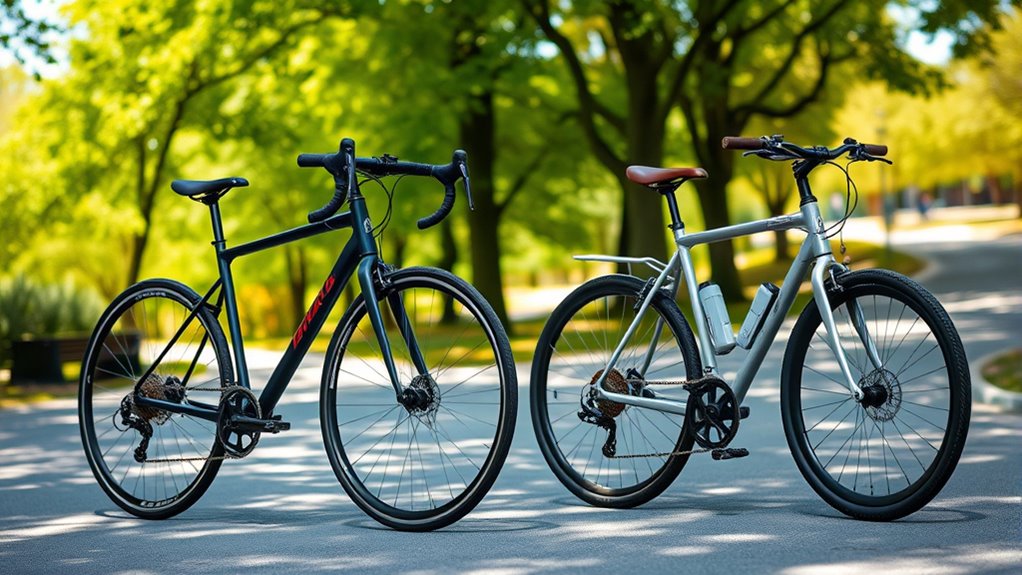
Choosing the right bike depends heavily on your riding terrain, comfort preferences, and performance goals. To decide between a hybrid bike and a road bike, consider these factors:
- Your primary terrain, whether mixed surfaces or smooth pavement
- Comfort needs, such as upright riding position versus forward-leaning posture
- Performance aims, like speed and efficiency versus versatility and durability
- Accessories required, including racks and mudguards for hybrids or lightweight frames for road bikes
- Your experience level, favoring beginner-friendly hybrids or more aggressive road bikes
Visualize yourself riding: a hybrid with flat handlebars and relaxed posture, or a sleek road bike with drop bars and aerodynamic stance. Your choice hinges on aligning these aspects with your cycling style.
Matching Your Riding Style With the Right Bike
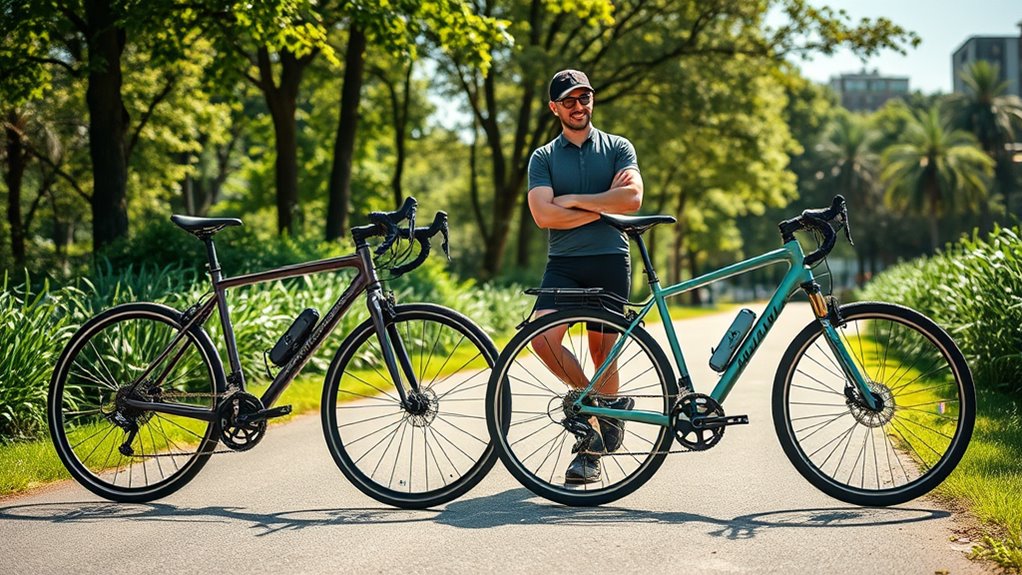
Matching your riding style with the right bike means understanding whether you prefer relaxed, casual riding or high-performance, long-distance cycling. If you prioritize comfort and versatility, a hybrid bike suits your riding style, offering an upright position and wider tires for mixed terrain. Its geometry and riding position provide control and comfort on various surfaces, making it ideal for commuting, light off-road adventures, and casual rides. On the other hand, if you focus on speed and efficiency, a road bike enhances your performance with aerodynamic geometry and a lightweight frame, perfect for paved surfaces and fitness rides. Choosing the right bike depends on your terrain and fitness goals, ensuring you get the best balance of comfort, control, and speed for your riding style.
Frequently Asked Questions
Should I Get a Hybrid or Road Bike?
You’re wondering whether to get a hybrid or a road bike. If you prefer relaxed riding, commuting, or tackling varied terrains, a hybrid is your best bet because it offers more comfort and versatility. But if speed, efficiency, and long-distance rides on smooth pavement excite you, a road bike will serve you better. Consider your riding style and terrain to choose the bike that matches your needs perfectly.
What Are the Disadvantages of a Hybrid Bike?
A hybrid bike is like a Swiss Army knife, but that versatility comes with downsides. You might find it heavier than a road bike, which slows you down on smooth pavement. Its relaxed riding position isn’t as aerodynamic, limiting speed. The complex gear system can require more maintenance, and wider tires increase rolling resistance. Plus, its less advanced components make it less ideal for racing or high-performance rides.
Can a Hybrid Bike Be Used on the Road?
Yes, you can definitely use a hybrid bike on the road. It’s designed for paved surfaces, offering a comfortable upright riding position and smooth 700c tires that help you go faster and more efficiently. With lightweight frames and versatile gear setups, hybrids handle road riding well, making them suitable for commuting, fitness, or casual rides. You can even upgrade tires and components to boost performance further.
Which Is Better for City Use, Road Bike or Hybrid Bike?
For city use, a hybrid bike is the better choice. It offers an upright riding position, flat handlebars, and wider tires, making it more comfortable and stable on urban streets. Hybrids also come with mounts for racks and fenders, perfect for commuting and carrying cargo. They’re easier to handle, require less maintenance, and handle potholes and uneven surfaces better, ensuring you get around the city efficiently and comfortably.
Conclusion
Choosing between a hybrid and a road bike is like picking the right shoes for a journey—you want comfort, performance, and versatility. I once thought I needed a speedy road bike, but a hybrid helped me explore city streets and trails effortlessly. Remember, your perfect bike should feel like an extension of yourself, ready for wherever your rides take you. Trust your needs, and you’ll find the one that keeps you moving happily forward.






